A Goldilocks Tale of the Two Prius Family Bookends
[Ed. Note: I guess it’s Goldlocks Plus 1. The Prius family now clocks in with four named members – the original Liftback, a Plug-In version and the two models reviewed here. It appears that Toyota is well on the way to making sure you won’t leave the dealership without one that’s “just right†for you–and Clean Fleet Report has driven them all.]
Prius c – The Littlest Prius – Small & Thrifty
The Prius c (the lower-case c is Toyota’s preferred style), first added to Toyota’s Prius Family (Liftback, Plug-in Liftback) and Prius V in 2013, is part of the best-selling hybrid car line in the United States. Various Prius have sold more than 1.5 million models in the last 10 years. The Prius was also the best-selling vehicle line in the state of California in 2012 and then backed it up again in 2013, a significant achievement for a hybrid.

The Prius c was introduced as the low-cost entry into this genre, offering excellent fuel economy and a different look from its siblings, since it is the only family member derived a different model (the Toyota Yaris subcompact).
Drivetrain
The front-wheel drive 2014 Prius c is powered by a parallel hybrid drivetrain, which Toyota calls the Hybrid Synergy Drive. In the parallel hybrid system the electric motor can power the car by itself, the gas engine can power the car by itself or they can power the car together.
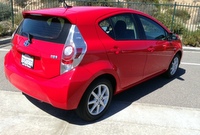
The Hybrid Synergy Drive system comprises a 1.5-liter DOHC (double overhead cam), four-cylinder gasoline engine with producing 73 hp through the Continuously Variable Transaxle (CVT), with an additional 26 hp supplied by the electric motor. The system delivers an EPA rating of 53 city/46 highway for a combined 50 mpg. There are three drive modes: Normal; EV, which forces the car to stay in all-electric mode at very low speeds for less than a mile, ECO, which delivers the best economy, but also clamps-down on the power output to sip fuel. ECO works best at a steady speed on a flat highway, where you don’t need to accelerate hard. It actually would not matter too much as the words “fast†and “Prius c†would never be uttered in the same breath. In time while pushing it hard, the Prius c will get up to freeway speeds and easily stay there for as long as you like, but you will hear the engine strain under hard acceleration and at freeway speeds there is considerable wind noise.
In 293 miles of 75-percent/25-percent highway/city driving, Clean Fleet Report achieved an impressive 49.6 mpg, which if we drained the 9.5 gallon tank would have taken us 450+ miles down the road.
Driving Experience: Exterior
At first glance the Prius c is sleeker, lower-slung and more rounded than the other Prius models, making it an eye-appealing design even for those that are not fans of the well-known Prius wedge shape. Its swept-back nose and hood lead to a tail with a wide spoiler, that looks, well, very non-Prius-like. Having recently reviewed the Honda CR-Z I was hoping the Prius c would also be a sporty hybrid to rival the Honda. Unfortunately, this was not the case, and to Toyota’s credit they do not position the c as a sporty car.
Driving Experience: On the Road
The five-door Prius c–or four-door liftback–weighs in at a nimble 2,500 lbs., which is 542 lbs. less than the classic Prius Liftback and 774 lbs. less than the Prius V wagon; this lower weight directly translates into better fuel economy. The weight is well-distributed due to the under-seat battery and fuel tank placement, resulting in a low center of gravity, which lets you toss the car around better than the c’s siblings. The c suffered from a harsher ride than the heaver Prius models, with a particularly rougher ride on the freeway. However, in parking lots, city streets and other tight maneuver areas, the Prius c is a joy to drive. It is agile and feels connected to the road. Toyota calls it “city-friendly size.†Hmm, I wonder of the “c†stands for City? [confirmed–ed.]
Our Prius c had 15-inch alloy wheels, standard on the model we were driving (with 16-inch only available as part of an option package), electrically power-assisted rack-and-pinion steering, front MacPherson struts with stabilizer bar and rear torsion-beam suspension – which all helped the car corner well, with little body roll.
Driving Experience: Interior
The 2014 Prius c has a roomy, airy interior with good sightlines and a more conventional dash and center stack lay-out that the other Prius models. To start with, the gear shift lever is mounted on the floor and the dash has an old-school feel with a combination of knobs, switches and buttons. We at Clean Fleet Report drive many different cars and it is nice to get back to a familiar design and system that isn’t all touch- and motion-based.
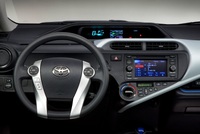
There are four Prius c models (One, Two, Three and Four) and Clean Fleet Report had the Three for a week. Standard equipment on the Three included automatic climate control, 6.1-inch touch-screen with navigation and Toyota’s Entune app suite. The Entune premium service, which is complimentary for three years, includes Bing, iHeartRadio, MovieTickets.com, OpenTable and Pandora; XM Data Services, iNavTraffic, NavWeather, Fuel, and Sports & Stocks.
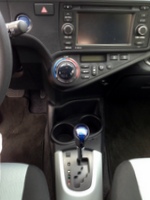
The six-speaker AM/FM CD player with MP3/WMA playback capability came with SiriusXM (which includes a 90-day trial subscription), HD AM Radio with an auxiliary audio jack, USB port with iPod connectivity and control, hands-free phone, advanced voice recognition and music streaming via Bluetooth wireless technology.
The tilt/telescopic steering wheel has all the usual buttons (audio volume and modes, phone, climate control and Bluetooth) and cruise control is on the right side stalk. Consistent with the other Prius models is that the gauges are off to the right a few degrees, located top-center of the dash, with none being directly in front of the driver. The center console has storage and is positioned well to rest your arm. Everything is within easy reach, easy to understand, so all-in-all, it’s a workable arrangement.
The Prius c comfortably seats four adults, or two adults up front and three children in the back seat. The six-way manual adjustable driver’s seat and front passenger four-way manual adjustable seat, covered in a two-toned cloth fabric with a swirl pattern, were easy to settle into. There are four cup holders and a 12V power outlet up front. With the rear seat folded flat, there is ample storage space, lending the Prius c to most likely being a two-person car where the back seat is rarely used for sitting.
The 2014 Prius c safety and convenience features are remote keyless entry, door handles with touch sensor lock and unlock, power door locks and windows, TPMS (Tire Pressure Monitoring System), VPNS (Vehicle Proximity Notification System), projector beam halogen headlights, nine airbags, adaptive cruise control, heated power outside mirrors, rear window wiper, hill assist, vehicle stability, traction control and ABS with brake assist.
Pricing and Warranties
The 2014 Prius c Model One base price is $19,080; the Model Two $20,030; the Model Four $23,360; and the nicely optioned Prius c Model Three I was driving based-priced at $21,765. All prices are MSRP and do not include the $810 destination charge. The 2014 Prius c comes with these warranties:
|
Observations: 2014 Toyota Prius c
The Prius c is a fun small car that has a much larger-car feel once inside.

The Prius c is the lowest priced model in the Prius family, but it should not be considered cheap. Its sales in the first half of 2014 were down slightly from 2013, so it remains a viable option for drivers looking for a nimble, high-mileage car that can seat up to four adults.
If you value paying as little as possible for each mile driven, then the Toyota Prius C should be on your shopping list. Yes, you will pay a bit more for a hybrid versus a gasoline or diesel-powered car. But, if you are putting a lot of miles on your car or like the ability to occasionally drive slowly around town in pure electric mode, then the additional initial expense will be worth it to you.
The reliability of the Prius and being the market-leading hybrid should give you confidence that this car will be in your garage for many, many years.
Prius V – The Extra Space Prius
The Prius V is part of Toyota’s Prius Family (Hatchback, Plug-in Hatchback and Prius c) that has made it the best-selling hybrid car line in the United States with more than 1.5 million Prius models sold in the last 10 years. The Prius was also the best-selling vehicle line in the state of California in 2012 and then again in 2013, which was huge for a hybrid.
The Prius V came along in 2011 as a wagon version of the original Prius Hatchback, offering very good fuel economy while delivering more carrying space.
Drivetrain
The front-wheel drive 2014 Prius V is powered by a parallel hybrid drivetrain, which Toyota calls Hybrid Synergy Drive. In the parallel hybrid system the electric motor can power the car by itself, the gas engine can power the car by itself or they can power the car together.
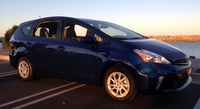
The Hybrid Synergy Drive system combines a 1.8-liter DOHC (double overhead cam), four-cylinder gasoline engine with a 60 kw electric motors to produce 134 hp through the Continuously Variable Transaxle (CVT), delivering 44 city/40 highway for a combined 42 mpg.
In 470 miles of 75-percent/25-percent highway/city driving, Clean Fleet Report achieved 41.6 mpg.
Driving Experience: On The Road
The four-door Prius V wagon weighs in at 3,274 lbs., which is 232 lbs. more than the sibling Prius Hatchback. The increased weight might account for the V getting lower fuel economy than the Hatchback: 44 city/40 highway/ 42 combined vs. 51 city/48 highway/50 combined. However, the weight is well-distributed due to the under-seat battery placement, resulting in a low center of gravity and actually made for a better driving experience. The V felt more balanced than the Hatchback and the freeway confidence level was better, especially when being passed by a semi-truck or in a windy mountain pass.
The electrically power-assisted rack-and-pinion steering, the front MacPherson struts with stabilizer bar and rear torsion-beam suspension delivers a smooth and fairly quiet highway ride. The Prius V had 16-inch alloy wheels standard on the model we were driving (with 17-inch only available on the next up-content package) which helped the car corner well with little body roll, but with no sense of feeling sporty. Note: if you are considering buying any Prius as a sporty car, you need to be looking elsewhere. There’s no head snapping going on with a 0 – 60 mph time of around 10 seconds, but, then again, off-the-line drag racing is not why a million and a half of these have been sold. So, expecting a performance level that Toyota never promised is unfair. But let’s get real on what is fair – fuel economy and, in the case of the V, carrying capacity of all your stuff.

Driving Experience: Interior
The 2014 Prius V has a spacious interior with a twin cockpit design – a center stack separating the bucket seats. The tilt/telescopic steering wheel has all the usual control buttons (audio, phone, cruise control, climate, Bluetooth, etc.) including the ability to switch between fuel and battery (hybrid) gauges. Another unique design feature is that the gauges are off to the right a few degrees, top-center of the dash, with none being directly in front of the driver. The gearshift selector pokes out of the dash in a convenient location that allows for storage areas on the console where a shift selector would usually be. All-in-all, it’s a workable arrangement.
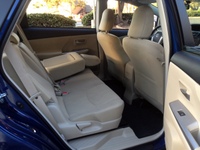
The Prius V comfortably seats four full-size adults, five for short trips. The six-way adjustable driver’s seat has power lumbar support, which helped with finding a comfortable driving position. The front passenger seat is four-way manually adjustable (with no lumbar adjustment) and has a convenient fold-flat feature. I thought the front bucket seats could use more thigh bolstering, but otherwise they were easy to settle into for a long trip without leg and back fatigue. Toyota has provided five cup holders in the cabin and there is a 12V power outlet in the front and cargo areas.
Where the Prius V really shines is the ample storage space, with or without the 60/40 rear seats folded flat. Lay them down, and for long items utilize the fold-flat front passenger bucket seat, and the V is very versatile whether you are antiquing, making a garden center run or hitting the beach with your surfboard.
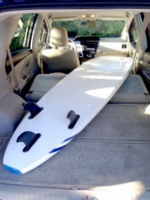
The car has good sightlines that are better than the Prius Hatchback as there is no spoiler cutting horizontally midway through the rear window. As in all Prius models, one oddity is that a beeper goes off inside the cabin when shifting into reverse since backing up is usually in EV mode. Odd because as the driver you know you put the car in reverse, the Rearview Camera pops-up on the screen and the beeping is not heard outside of the car where it would be the most useful. Of course, since we live in the Internet age, a quick Google search of “Prius Back-Up Beep†will lead you to a variety of homegrown fixes.
There are three Prius V models (Two, Three and Five) and Clean Fleet Report had the Three for a week. Standard equipment on the Three included a 6.1-inch touch-screen with navigation, back-up camera and Toyota’s Entune app suite. The Entune premium service, which is complimentary for three years, includes Bing, iHeartRadio, MovieTickets.com, OpenTable and Pandora; XM Data Services, iNavTraffic, NavWeather, Fuel, and Sports & Stocks.
The six-speaker AM/FM CD player with MP3/WMA playback capability came with SiriusXM (which includes a 90-day trial subscription), HD AM Radio with an auxiliary audio jack, USB port with iPod connectivity and control, hands-free phone, advanced voice recognition and music streaming via Bluetooth wireless technology.
Safety and Convenience
The 2014 Prius V is well-equipped for safety and convenience with remote keyless entry, power door locks, TPMS (Tire Pressure Monitoring System), projector beam halogen headlights, seven airbags, adaptive cruise control, heated power outside mirrors, rear window wiper, hill assist, vehicle stability, traction control and ABS with brake assist. Upgrading to the Prius V Five model gets as standard equipment, a pre-collision and parking guidance system and Toyota’s Safety Connect service, which has many of the features found on General Motor’s OnStar service.
Driving Experience: Exterior
The Prius Hatchback is probably the most recognizable vehicle on the road with its wedge shape, designed to reduce wind resistance and drag to increase fuel economy. The Prius V wagon shape is more appealing with a more balanced silhouette, and my opinion is the best looking of the Prius models.
Pricing and Warranties
The 2014 Prius V Model Two base price is $27,560 with the nicely optioned Prius V Model Three I was driving priced at $28,550. The pricing for the Model Five will top out at around $36,855.

All prices are MSRP and include the $810 destination charge. The 2014 Prius V comes with these warranties:
- 3-year/36,000-mile Comprehensive
- 5-year/60,000-mile Powertrain
- 5-year/unlimited-mileage Corrosion
- 8-year/100,000-mile Hybrid-related Component Coverage
- 15-year/150,000-mile Hybrid-related Component Coverage (applicable states are: CA, MA, NY, NJ, VT, CT, ME, NM and RI) with the exception of the hybrid battery. The hybrid battery is warranted for 10 years/150,000 miles.
- Toyota Care – Complimentary maintenance plan and roadside assistance with the purchase or lease of every new Toyota. For 2 years or 25,000 miles, whichever comes first.
Observations: 2014 Toyota Prius V
Clean Fleet Report has now reviewed the entire Prius family. We recently reviewed the 2014 Prius Hatchback and Prius Plug-in Hatchback which you can read here.
The bottom line for considering a hybrid is acknowledge the type of driving do you do and whether getting high fuel economy, whether for budgetary or environmental reasons – or both – a key to your decision. With the Prius V you get to add cargo-stowing functionality to the equation.
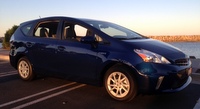
Whether you spend your time tooling around in-town or are venturing out on the open road, if you value paying as little as possible for each mile driven, then the Toyota Prius V should be on your shopping list. Not many cars get the outstanding fuel economy of the Prius family.
Yes, you will pay a bit more for a hybrid versus a gasoline-powered car. But, if you are putting a lot of miles on your car or like the ability to occasionally cruise around town in pure electric mode, then the additional initial expense will be worth it to you.
The reliability of the Prius as well as its reputation as the market-leading hybrid should give you confidence that this car will be in your garage for many, many years.
Whatever you end up buying, enjoy your new car and as always, Happy Driving!
Other related stories you might enjoy:
Road test of the Prius cousin, the Camry Hybrid
Best Electric Cars and Plug-ins for 2014

0 thoughts on “Road Test: 2014 Toyota Prius c and Prius V Hybrids”